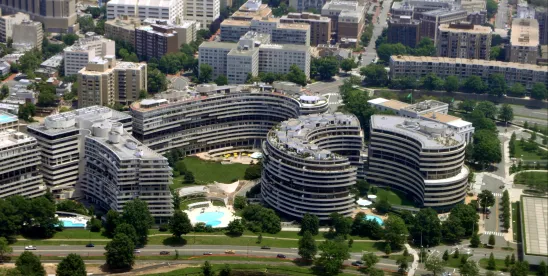When most people think about the Supreme Court’s impact on the Watergate scandal, they think about United States v. Nixon, 418 U.S. 683 (1974), the case in which a unanimous Court ordered the Nixon Administration to turn the White House tapes over to Special Prosecutor Leon Jaworski. Few people today remember another 8-0 Supreme Court decision, United States v. U.S. District Court, 407 U.S. 297 (1972). (Justice William Rehnquist recused himself from both cases because of his recent work in the Nixon Justice Department). This 1972 case is perhaps the key to understanding the fundamental issue involved in the Watergate scandal.
The Nixon Administration’s Justice Department brought a series of conspiracy cases against anti-Vietnam War and other left-wing organizations. The most famous of these is the “Chicago 7” case. One of these conspiracy prosecutions was against a small left-wing group in Detroit charged with conspiracy to destroy government property in an alleged plot to destroy a CIA office.
In a pretrial motion seeking disclosure of illegally obtained evidence for use in a possible suppression hearing, the defense asked the government to turn over transcripts from any warrantless wiretaps on the defendants’ telephones. The FBI often conducted such illegal wiretaps against anti-war groups during both the Johnson and Nixon Administrations. Typically, federal prosecutors responded to requests for such information by denying that there had been any warrantless wiretaps. In this case, however, the prosecution surprisingly admitted that there had been warrantless wiretaps.
The trial judge ordered the transcripts of the wiretaps turned over to the defense. The prosecution responded with a brief asserting that the Attorney General, in his sole discretion, could sidestep the Fourth Amendment’s warrant requirement in the interests of national security. The trial judge curtly dismissed this argument, stating that “we are a nation of laws and not of men.”
The prosecutors doubted that they could obtain an interlocutory appeal of this order. They wanted a decision on their theory that the Attorney General could bypass the Fourth Amendment’s warrant requirement as soon as possible. Therefore, they took the unusual step of seeking a writ of mandamus against the trial judge, Damon Keith, asking the 6th Circuit to order Judge Keith to reverse his decision.
The so-called “inherent power” theory was developed under the direction of Attorney General John Mitchell with the help of Assistant Attorneys General Richard Kleindienst, Robert Mardian, and William Rehnquist. Mitchell, Kleindienst, and Mardian were all later convicted of various crimes in connection with the Watergate scandal. The implication of the “inherent power” theory was not only that the Executive Branch had the power to circumvent the Fourth Amendment but that the Executive Branch had the power to suspend any portion of the Constitution if, in its sole discretion, it deemed that the interests of national security required it.
In support of its argument in the 6th Circuit, the Justice Department relied upon case law from English Courts in the 15th, 16th, and 17th Centuries, asserting the “inherent power of the crown.”
In rejecting the Justice Department’s argument, the chief judge of the 6th Circuit wrote, “It is strange indeed, that in this case, the traditional power of sovereigns like King George III should be invoked in [sic] behalf of an American president to defeat one of the fundamental freedoms for which the founders of this country overthrew King George’s reign.”
The Justice Department appealed this decision to the Supreme Court, which ruled 8-0 against the government and upheld the trial court and the 6th Circuit. This majority included three justices appointed by Nixon himself.
One of the lawyers arguing for the defense before the Supreme Court was Rutgers law professor Arthur Kinoy. In his 1984 book, Rights on Trial, Kinoy argues that what was fundamentally at issue in the Watergate episode was a well-planned effort by the Nixon Administration to obtain legal sanction for the inherent power theory, thus allowing the President to sidestep the Fourth Amendment, and by the same logic, other provisions of the Constitution, without any judicial constraint. This effort was halted by the Supreme Court’s decision in U.S. v. U.S. District Court.
Professor Kinoy notes that two days before the Supreme Court’s decision in U.S. v. U.S. District Court was announced, five burglars were apprehended by the police at Democratic National Headquarters at the Watergate Hotel in Washington. The burglars told the police that they were there to remove a defective bug, but they had a much larger number of listening devices in their hands.
We may never know the whole story, but Professor Kinoy suggests that the burglars were likely present to remove all the bugs that had previously been placed at the Watergate. The Watergate conspirators probably assumed that the inherent power theory would be adopted by the Supreme Court, thus providing a post hac legal sanction to the bugging of the Democratic Party’s national headquarters. It is possible that the Supreme Court’s contrary decision leaked out before its announcement and that the burglars were rushed into the Watergate to remove the bugs, the placement of which would now not be rescued from illegality by the Supreme Court.




 />i
/>i

